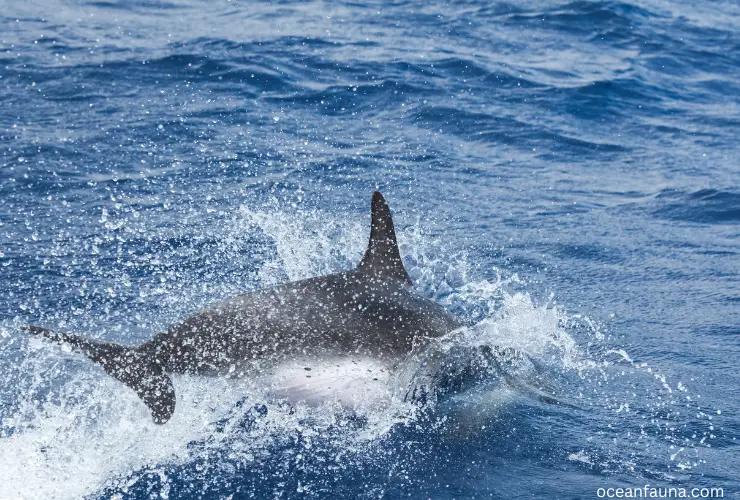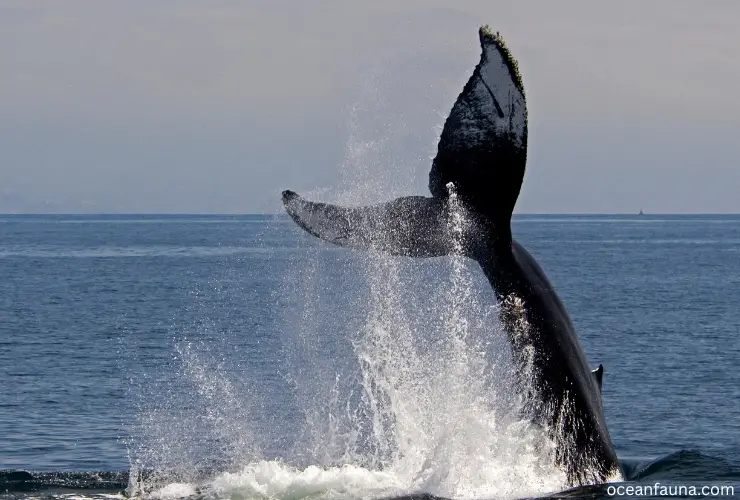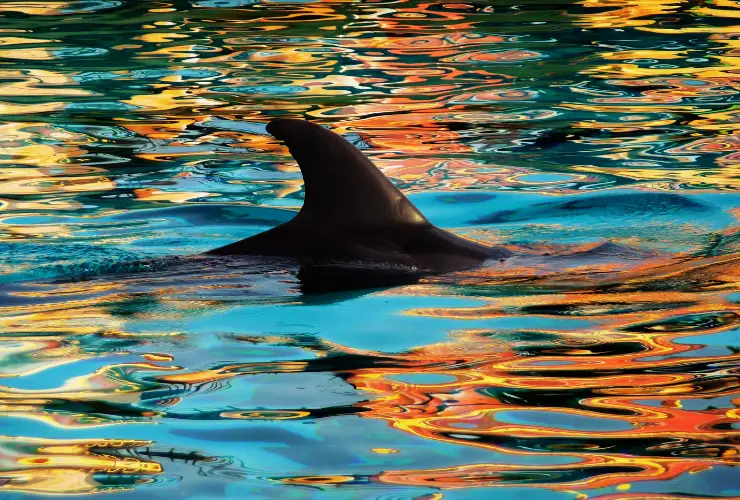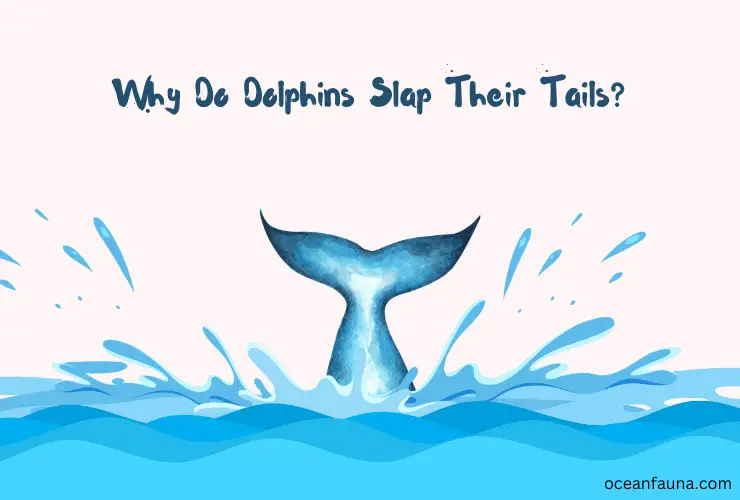Have you ever witnessed a dolphin slapping its tail? If so, or if you’ve seen clips of it in documentaries, this article will explain why. To get started, I must point out that dolphins don’t slap their tails for any one specific reason. Instead, they may do so to stun fish by creating waves, communicate with others in the area, and/or accomplish other tasks.
Let’s delve right into the main subject of this article without wasting any more time. I am ready to provide further details and insights on the topic at hand.
Anatomy of a Dolphin’s Tail
The anatomy of a dolphin’s tail is truly remarkable. Dolphins belong to the mammalian class, and their tails, also known as flukes, are one of the reasons why they are considered one of the most advanced marine animals. A dolphin tail consists of two flukes connected by a central ridge called the dorsal fin.
The flukes comprise dense connective tissue and cartilage, which helps them maintain their shape and stability. The flukes are also covered in a layer of skin, which is smooth and streamlined to allow for easy movement through the water.
The dolphin’s muscular system lies within the flukes, which propel the animal forward. The main muscle group is known as the peduncle, which runs along the length of the tail. This powerful muscle is what allows dolphins to swim at speeds of up to 60 km/h, making them one of the fastest animals in the ocean.
In addition to the peduncle, dolphins also have a series of smaller muscles that control the movement of their flukes. These muscles are incredibly flexible and allow for precise movements, such as quick turns or sudden stops.
Another vital part of a dolphin’s tail is the dorsal fin. This fin acts as a stabilizer, helping to keep the dolphin balanced as it swims. While the dorsal fin is not strictly part of the tail, it is still an essential component of the dolphin’s overall anatomy.
Why Do Dolphins Slap Their Tails?
Dolphins are known for their remarkable intelligence and unique behavior; tail slapping or kerplunking is one of the most noteworthy. Dolphins slap their tails against the water’s surface for various reasons, including feeding, communication, socialization, and warning. Let’s explore each of these reasons in detail.

Feeding
Dolphins are opportunistic feeders and can hunt a variety of fish and squid species. When they spot a school of fish or a solitary fish nearby, they use various tactics to catch their prey. Kerplunking is one of them.
By propelling their tails against the water with great force, dolphins create a shockwave that stuns fish and makes them easier to catch. This method is especially useful for fish that are fast-moving or difficult to capture.
Communication
Dolphins use a sophisticated vocal and non-vocal communication system to interact with one another. Tail slapping is one of the non-vocal cues that dolphins use to convey a message.
The type of tail slap and its intensity can indicate different things. For example, a gentle and soft tail slap can signal attention-seeking behavior or excitement. On the other hand, a sudden and forceful tail slap can mean aggression or a warning to other dolphins in the group.
Socialization
Dolphins are highly social animals and spend much of their time interacting with other pod members. Tail slapping is one of the ways dolphins bond with each other. When two dolphins meet for the first time, they may engage in a playful tail slap to get to know each other.
In a similar way, dolphins swimming together will sometimes slap their tails at the same time. This creates a synchronized pattern that helps the dolphins get along better with each other.

Warning
Tail slapping can also be a sign of warning to other dolphins or predators in the area. A sudden and loud tail slap can alert other dolphins to potential danger or signal aggression towards other animals.
Additionally, dolphins use tail slapping to create a disturbance in the water that can startle or drive away predators. By slapping their tails repeatedly, dolphins can create a commotion that makes it harder for predators to locate and capture them.
Playing
Tail slapping is used for communication, hunting, and play. Dolphins are known to engage in playful tail-slapping contests with each other as a form of entertainment. This behavior can take the form of two dolphins performing synchronized tail slaps in a friendly competition or one dolphin doing repeated solo tail slams.
How Do Dolphins Slap Their Tails?
Dolphins are known to be incredibly agile swimmers, and one of their most impressive moves is the powerful tail slap. The technique involves the dolphin flipping its tail upwards and then slamming it down onto the surface of the water.
Interestingly, dolphins slap their tails for a variety of reasons. Sometimes it’s simply for fun or to communicate with other dolphins in the area. Other times, it’s to stun or incapacitate prey during hunting – all the reasons are discussed above.
When performing a tail slap, the dolphin first arches its back and flips its tail upwards above the surface of the water. It then rapidly accelerates the movement of its tail downwards, creating a loud smacking sound as it hits the water.
The force of the impact can be incredibly powerful, with some dolphins able to create a slight wave when they slap their tails.
Do Dolphins Slap Their Tails Out of Anger?
While it is commonly believed that dolphins may slap their tails when angry, this behavior is quite rare. In fact, researchers have found that dolphins are more likely to bite or exhibit aggressive body language when they feel threatened or upset.
That being said, there are instances where dolphins have been observed slapping their tails as a form of communication or to attract attention. For example, bottlenose dolphins have been known to slap their tails on the water’s surface to signal to other dolphins in their pod that they are ready to hunt for food.
Dolphins, like all animals, have complex emotions and behaviors that can be difficult to interpret. While tail slapping may sometimes indicate annoyance or frustration, it is not necessarily a reliable indicator of a dolphin’s emotional state.
Instead, scientists look for various cues, such as body posture, vocalizations, and social interactions, to better understand how dolphins communicate and express their feelings.
Do Dolphins Slap Their Fins?
Yes, dolphins do slap their fins as they do with their tails. More specifically, they slap their pectoral fins, also known as their flippers. They can slap their fins on the surface of the water or on their own bodies, such as their belly.

This behavior is primarily associated with communication and play. Dolphins use a variety of vocalizations, such as whistles and clicks, to communicate with each other, but they also use their body language to convey messages.
By slapping their fins, dolphins can create a loud, distinctive sound that can be heard by other dolphins nearby. They may use this sound to signal danger, get another dolphin’s attention, or establish dominance.
Additionally, dolphins are known for their playful behavior, and slapping their fins may also be a form of play or excitement.
Overall, the act of dolphins slapping their fins is a fascinating behavior that provides insight into these intelligent creatures’ complex communication and social dynamics.
How Do Dolphins Hunt Except by Tail Slapping?
Dolphins are highly intelligent and use various hunting techniques to catch their prey. In addition to tail slapping, dolphins also use echolocation to locate their prey and communicate with one another during the hunt. They often work together to herd schools of fish into tight clusters, making it easier for them to catch their meal.
Some species of dolphins, such as the bottlenose dolphin, are known to use a technique called “fish whacking.” This involves striking a fish with its tail to stun it before scooping it up with its mouth. Other dolphins, such as the orca, are apex predators that hunt in packs and have been known to take down large prey such as sharks and even whales.
Dolphins are also known for their ability to use tools while hunting. They have been observed using sponges to protect their nose while foraging on the seabed, and some have even been seen using conch shells to trap fish.
Conclusion
Hopefully, you got your answer on why and how dolphins slap their tails. So many reasons, from feeding to communication, and dolphins use tail slapping to express themselves.
If you have further questions regarding this, keep your question in the comment box. I will answer them.


3 thoughts on “Why Do Dolphins Slap Their Tails? Know Details”